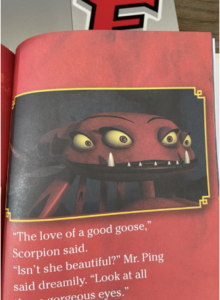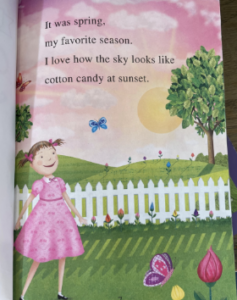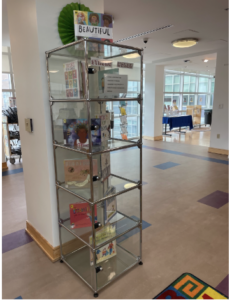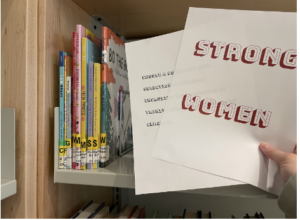Access to Gender-Inclusive Children’s Picture Books in Public Libraries
Community Learning Research Fellow Katie Cerulle ’22
with Hartford Public Library and West Hartford Public Library
and Faculty Sponsor, Professor Dan Douglas
Spring 2022, Trinity College, Hartford CT
Abstract
My Educational Studies senior research project demonstrated that there is still a disparity in the amount of content available in public libraries that features strong female characters. In order to address this issue, I decided to return to the Hartford and West Hartford libraries to collaborate on this semester-long project. My research questions for this project were:
How do public libraries perceive the gendered content in their collection? How do they respond to my study?
Given the community partnership, I also document action steps taken to improve their collections.
Why it matters
In addition to my own research bringing clarity to this issue, there have been nationwide and local movements that address access to gender-inclusive texts in school libraries. One Washington Post article depicts the experience of a few librarians across the country that are struggling to keep books that discuss gender, sexuality, race, or LGBTQ+ content on the shelves. Debates between parents, school boards, and libraries themselves have forced the librarians to take books off the shelves themselves in order to avoid strict fines or even jail time. Locally, West Hartford School District is struggling with critiques of the school’s new social and emotional learning approach to teaching. The social and emotional learning curriculum involves looking at education through an equity lens and takes the time to have children learn about individuals who are different from themselves. Given my own research and the national discussion about the texts available to children, this project grew out of my desire to leave a lasting impact on an issue I feel passionate about: children having access to gender-inclusive literature.
Summary of prior research
Senior Thesis Research
This project came to fruition through my senior thesis assignment for my Educational Studies major. For the assignment, I chose to go to both the West Hartford and Hartford public libraries and select 10 books from each collection in order to do a comparative study. At each library, I selected 5 early reader books and 5 picture books. I chose the books by random selection. I counted the number of shelves and, using a random number generator, selected 5 shelves. Then, I counted the number of books on each shelf and, using a random number generator again, selected 5 books, one from each shelf. From the 10 picture books and early readers that I chose, I deciphered how the author represented the roles, personality traits, and appearances of the female characters. I combined the results from the libraries because there was little difference in the results from each library. For roles, out of the 17 total books that displayed gender, 11 had under 50% of the actions completed by the main character be stereotypically female. For personality, out of 17 total books, 12 of them had over 50% of the personality traits of the main female character be stereotypically female. Finally, the appearance of women had the worst statistics. Out of the 17 books that represented female characters, 12 featured the main female character in 100% stereotypical female clothing. I found these percentages by adding up the total number of defined feminine actions and dividing it by the total. The image on the right is one of the photos from the books I selected from the Hartford library called Kung Fu Panda: Legends of Awesome. The insect in this image, who is the only female character in the book, is wearing makeup. This is a startling image of how women are displayed; always done-up, even in insect form.

The image on the left is from a book I selected called Pinkalicious by Victoria Kann, also from the Hartford library.

This book takes us through the day of a female main character named Pinkalicious, who only wears pink bows and dresses. The main character of this story does not have a first name and is totally defined by a stereotypically female color. The results of my research demonstrated that women in children’s literature are starting to hold different roles in stories, but still have to feel and look like women. That is to say, the personalities and appearances of these women are starkly stereotypical despite the slight advancement in the activities the women complete. During my final presentation, Professor Dougherty suggested that I take the research I had completed about the available books in the Hartford and West Hartford libraries and bring it back to them. Copies of both of these books also exist in the West Hartford library.
Findings
Community Partners Perceptions
My community partners for this project have been both the Hartford and West Hartford public libraries. My connection with the librarians from each library grew organically out of my senior thesis project and continues to be a wonderful relationship.
The Hartford Public Library has been extremely receptive to my research and supportive of my ideas. The library has an extensive collection of gender-inclusive books, and has recently started doing Drag Queen story hour at the main branch. Even though the story hour received some pushback, the events have continued through the past few months, and will remain on the library’s schedule indefinitely. Hartford Library CEO Bridget Quinn-Carey said that the event is supposed to engage kids in reading and expose them to lifestyles that may be different than their own. Because of Hartford library’s extensive outreach efforts into community representation and their relevance to my senior thesis project, I reached out to them in early January and they agreed to partner with me. Throughout the long email chains with Lina Osho-Williams, Youth Services Manager, and the meetings with all directors of Hartford public library branches, they have been outstanding in their compliance, suggestions, and overall acceptance of my ideas to better their collections.
I also connected with Carol Waxman at the West Hartford Public Library main branch, the Noah Webster branch. I found her email from the business card she gave me during my senior research project, and we also connected in early January. She listened to my findings and was receptive to my critiques of the collection. We discussed my study and she provided her input for ways that I could improve the West Hartford collection.
Access to gender-inclusive children’s literature
In order to organize my research, I created a table that featured the books, authors, and links to the catalogs of the libraries that specified how many copies there were. I chose this organizational style in order to find out how many copies of each book exist in each library so that I could determine which ones to purchase with the CLIC funds. In my research, which was done through both online catalogs, I found out more information about which kinds of books were included in each collection, and more importantly, how many.
I selected the books to include in the table from the list of quality, gender-inclusive picture books that the Hartford Public Library managers created for my project and from online resources of recommended texts. Additionally, the books of a different font on the table were books I located in the Park at the Lyric branch, which is a Hartford library. I was surprised to find out that the West Hartford library owned significantly fewer copies of these gender-inclusive titles. In this section of the chart, there are 6 books out of 11 total; that WHPL does not own a copy of, while for Hartford it is only three. In the entire chart, out of 23 total book entries, WHPL did not own a copy of 13 books, while HPL did not have copies of 4.
The books that were most easy to find in the catalogues did not fall into a certain category. There were women-centric picture books, books where male characters redefined gender roles, and ones that featured children searching for their own gender identity.
My final research finding from the table was the web of libraries that were connected to WHPL. Multiple suburbs have a linked library network where parents can request a book to be delivered to WHPL. This idea is excellent in theory, given that it provides greater access to books, but it means that parents would have to research what books to request, wait, then pick them up. Many parents do not have the time to research quality books, making this an inequitable search tool.
I also used this table in order to recommend books for both of the libraries to add to their collections. I created a list that had the number of copies and which books to purchase for each library by using this this table.
The title is in the left hand column, then author, year, and the links and number of copies in each library.
Click to see the full data table
Outreach and Deliverables
The Displays
Over the past three months of collaboration with my community partners, I have worked with them to create feasible final products that would put my work on display. For the Hartford Public Libraries, the project included completing a few tasks that incorporated my research findings into the everyday life of library go-ers.

They asked me to create two permanent shelves in two different branches that house all of their gender-inclusive texts. I have started this shelf in the park street branch and have finished the permanent display in the main library branch.
The picture on the right side is the main branch library display. I selected the books that go inside the display by using my table of books and books that I found in the library. I made a sign that is pasted on the board that reads, “Check out this display of gender-inclusive texts curated by Trinity College

Senior Katie Cerulle” and the sign above says, Strong Women. I felt very emotional after putting this shelf together because it felt like a year’s worth of hard work was packaged into one beautiful display. The picture on the left side is the shelf that I created at the Park Branch at the Lyric library. The shelf is completed except without a title, but that will be finished by the beginning of May.
The Pamphlet
In addition to these permanent shelves, the Hartford library has also asked me to complete a pamphlet that will be a virtual guide for library go-ers. It will have information about my senior project, photos, and the location of the books / shelves in different branches. On the front page of the pamphlet, I plan to use an introductory photo and the title of my project. The next panel will have another photo with a more detailed description of the project. The next two panels will have the books that I chose and that are in the library, and some of their locations in different branches. Finally, the back will include my own data and notes on my research.
Purchasing of Books
CLIC has provided me with a spending budget of $500 dollars to provide new books to both libraries that contributed to my presentation.
During my conversation with the West Hartford Library, we decided that I would select some books for the library and they would have a name card inside of them that indicated hand-selected by me as a product of my thesis project. These books will be chosen through the table that I made which indicates which books the library has no copies of.
The Hartford Library will also get new books, including more copies of books they have and new books that I have done research to provide.
Conclusion
For this project, I took my research, which discovered the inequity of female representation in children’s literature, back to the libraries and asked them about their expectations, their reactions, and their suggestions. I found that both libraries had lots of suggestions on how to improve their collections. The Hartford library was largely involved with my project, providing continued encouragement and support. The West Hartford library provided feedback and support for my project as well. In order to accommodate the needs of the Hartford Library, I created a bookshelf in two branches, a pamphlet, provided new books, and gave suggestions on which books to purchase in the future. For the West Hartford Library, I suggested books for them to purchase in order to improve their collection.
Acknowledgements
I’d like to thank Lina Osho-Williams for organizing my connections with Hartford Library employees, Nancy Mendez for allowing me to create a shelf in the Park Street Lyric Branch, and Carol Waxman from West Hartford Public Library for meeting with me and allowing me to share my work. I’d also like to thank Professor Douglas and Jack Dougherty for supporting me along the way.
